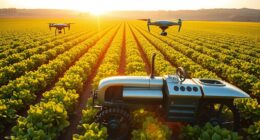To develop effective agroforestry systems for carbon storage, choose native, fast-growing trees with deep roots and diverse species to boost biomass and habitat complexity. Arrange trees and crops strategically to maximize light, airflow, and soil retention, while managing livestock rotations and organic amendments to enhance soil health. Incorporate biodiversity, monitor progress, and consider policies that support incentives and stakeholder engagement. Continuing will reveal practical strategies to maximize carbon sequestration and ecosystem resilience.
Key Takeaways
- Prioritize native, high-biomass tree species with deep roots to enhance soil carbon sequestration.
- Design diverse plant layers and structural complexity to increase biomass and habitat heterogeneity.
- Implement organic amendments like compost, manure, and biochar to boost soil organic carbon levels.
- Optimize spatial arrangements and planting densities to reduce competition and improve biomass accumulation.
- Incorporate crop rotation, cover crops, and biodiversity practices to improve soil health and carbon storage capacity.
Selecting Tree Species for Maximum Carbon Sequestration

Choosing the right tree species is vital for maximizing carbon sequestration in agroforestry systems. You should prioritize fast-growing, high-biomass trees that can absorb more carbon over their lifespan. Native species are often better suited because they adapt well to local conditions, requiring less maintenance and fertilizers. Consider trees with deep root systems, as they store carbon both above and below ground, increasing overall sequestration. Leaf litter and biomass contribute to soil carbon, so selecting species with substantial leaf production boosts soil health and carbon storage. It’s also essential to think about the trees’ lifespan and growth rate, ensuring they mature quickly and sustain long-term carbon capture. Additionally, choosing appropriate tree management practices can significantly enhance carbon storage efficiency. By choosing appropriate species, you enhance both the ecological and climate benefits of your agroforestry system.
Designing Effective Spatial Arrangements in Agroforestry
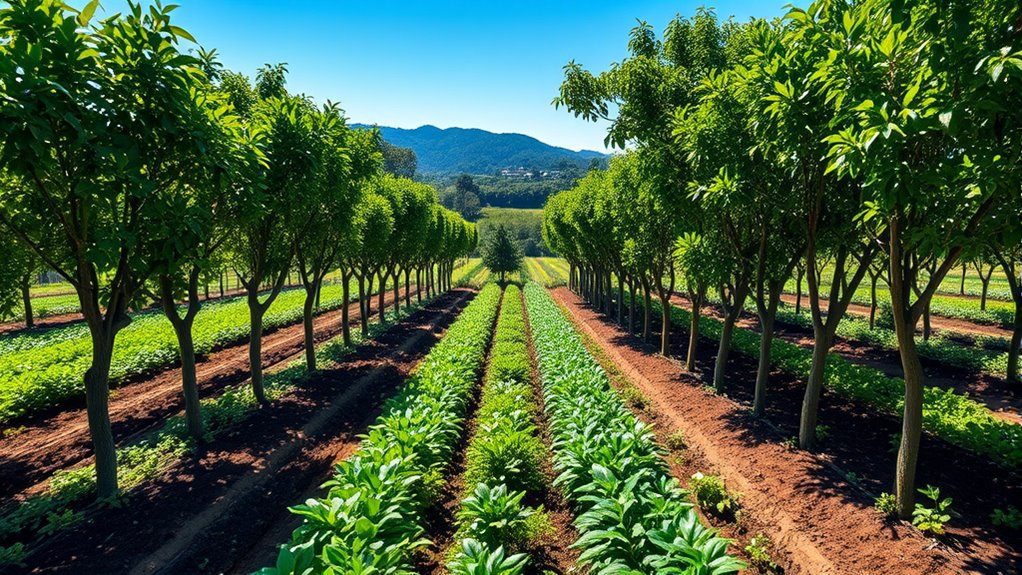
You need to optimize the spatial pattern to maximize carbon storage and overall system efficiency. Consider how layering and planting density influence tree growth, resource use, and carbon sequestration. By carefully arranging these elements, you can create a more productive and sustainable agroforestry system. Incorporating plant support solutions such as trellises or shade trees can further enhance system resilience and productivity.
Spatial Pattern Optimization
Optimizing the spatial arrangement of trees, crops, and other components in agroforestry systems is crucial for maximizing carbon storage. Proper spatial patterns enhance biomass accumulation and increase soil carbon sequestration. To achieve this, you should consider:
- Proximity of trees and crops to reduce competition and promote symbiosis.
- Distribution patterns, such as mixed or block planting, to improve light use and airflow.
- Alignment with topography to minimize erosion and optimize water retention.
Effective spatial planning ensures that plant interactions boost carbon capture without compromising productivity. It also promotes microclimate regulation and biodiversity, contributing to a resilient system. By carefully designing these arrangements, you can notably enhance the carbon storage capacity of your agroforestry system while maintaining land efficiency.
Layering and Planting Density
Effective layering and planting density are essential for creating a balanced agroforestry system that maximizes carbon storage and maintains productivity. You should carefully arrange different plant strata—such as trees, shrubs, and ground cover—to optimize space use and light capture. Dense planting can increase biomass, boosting carbon sequestration, but too much density may reduce growth and airflow, risking disease. Aim for an optimal balance by adjusting spacing based on species growth habits and canopy sizes. Incorporate diverse layers to improve resource use efficiency and promote resilience. Proper spacing ensures each plant receives adequate sunlight, water, and nutrients, enhancing overall system health. Additionally, automation technologies can assist in monitoring plant health and optimizing spacing to improve system performance. By skillfully managing layering and density, you create a robust, productive system that effectively captures and stores carbon.
Integrating Livestock and Crop Management Practices
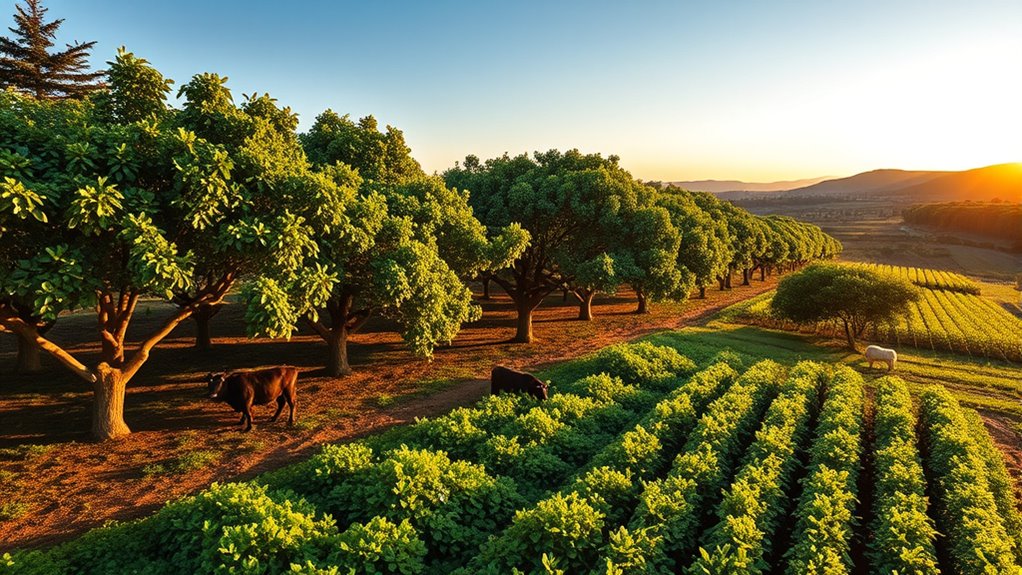
Integrating livestock and crop management practices can considerably enhance the sustainability and carbon sequestration potential of agroforestry systems. By carefully combining these elements, you create a balanced ecosystem that improves soil health and reduces emissions. To maximize benefits, consider these strategies:
- Rotate grazing areas to prevent overgrazing and promote healthy plant growth.
- Use manure as a natural fertilizer, enriching the soil with organic carbon.
- Incorporate cover crops alongside livestock grazing to protect soil and boost organic matter.
- Regular maintenance and monitoring of shower fixtures can prevent leaks and conserve water, indirectly supporting sustainable farming practices.
These practices help maintain soil structure, increase organic carbon levels, and reduce reliance on chemical inputs. Proper integration guarantees that livestock contribute to, rather than deplete, the system’s carbon storage capacity, making your agroforestry more resilient and environmentally friendly.
Enhancing Soil Carbon Storage Through Organic Amendments

Building on practices that improve soil health through livestock and crop management, adding organic amendments can considerably boost soil carbon storage. Organic materials like compost, manure, cover crops, and biochar enrich soil organic matter, enhancing its capacity to sequester carbon. These amendments stimulate microbial activity, improve soil structure, and increase nutrient retention. To maximize benefits, select amendments based on soil needs and crop requirements. Incorporating organic amendments is a practical way to enhance agroforestry systems’ carbon storage potential. Here’s a quick comparison:
| Organic Amendment | Primary Benefit |
|---|---|
| Compost | Improves soil structure and nutrients |
| Manure | Adds organic matter and nutrients |
| Cover Crops | Protects soil and adds biomass |
| Biochar | Stabilizes carbon and boosts fertility |
| Mulches | Reduces erosion and conserves moisture |
Additionally, understanding the role of attention in the management of soil health can lead to more effective implementation of these practices.
Monitoring and Measuring Carbon Storage in Agroforestry Systems
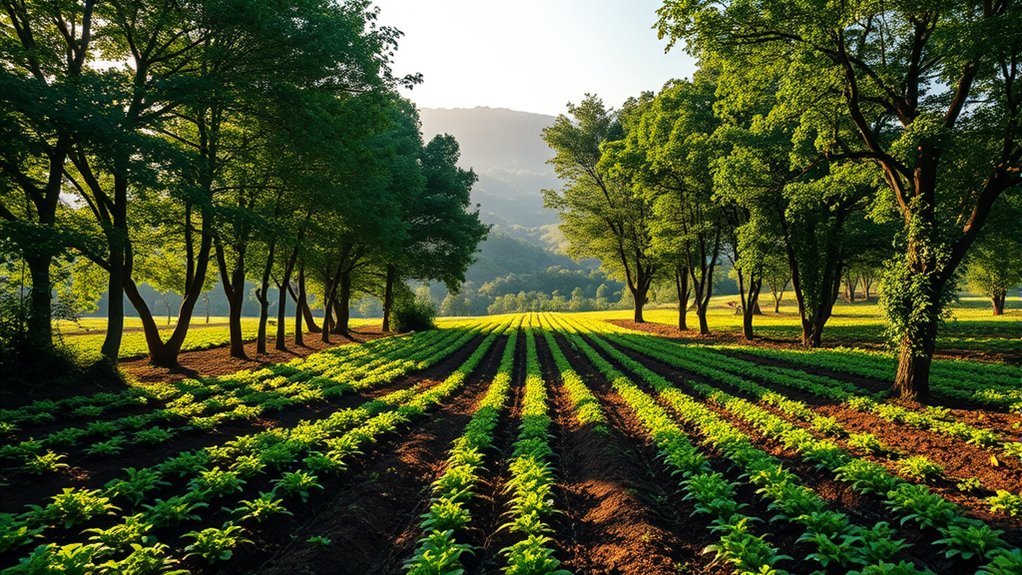
Monitoring and measuring carbon storage in agroforestry systems is essential to evaluate their effectiveness in mitigating climate change. Accurate assessment helps you understand how well your system sequesters carbon and informs management decisions. To do this effectively, consider these key steps:
- Use standardized protocols for soil and biomass sampling to ensure consistency.
- Employ remote sensing tools like drones or satellites for large-scale monitoring.
- Incorporate portable devices for rapid, on-site measurements of soil carbon levels.
- Recognizing the importance of lifestyle adjustments can enhance overall system sustainability and community engagement.
Promoting Biodiversity and Ecosystem Resilience

You can boost biodiversity by increasing habitat diversity and integrating native species into your agroforestry system. This approach not only supports a variety of plants and animals but also strengthens the ecosystem’s resilience. Additionally, promoting native plants helps naturally control pests and diseases, reducing reliance on chemical interventions. Implementing weather forecasting techniques can help optimize planting and harvesting times to maximize productivity and sustainability.
Habitat Diversity Enhancement
Enhancing habitat diversity within agroforestry systems plays a pivotal role in promoting biodiversity and strengthening ecosystem resilience. By creating varied habitats, you support a wide range of species, which helps ecosystems recover from disturbances. To maximize benefits, consider these strategies:
- Incorporate multiple plant layers, including canopy, understory, and ground cover.
- Maintain patches of native vegetation to provide refuge and breeding sites.
- Design structural complexity with trees, shrubs, and herbs to support diverse fauna.
- Diversifying investments within your agroforestry system can further enhance ecosystem stability and productivity.
These practices increase habitat heterogeneity, making your system more resistant to pests, diseases, and climate fluctuations. A diverse habitat structure also encourages beneficial insects and pollinators, which enhance productivity. Ultimately, fostering habitat diversity strengthens the ecological stability and long-term sustainability of your agroforestry system.
Native Species Integration
Integrating native species into agroforestry systems is essential for boosting biodiversity and enhancing ecosystem resilience. By including plants that naturally occur in your area, you support local wildlife and create a balanced environment. These species adapt better to local conditions, reducing the need for extra inputs and increasing system stability. Imagine a vibrant landscape:
| Native Trees | Understory Plants | Wildlife Habitat |
|---|---|---|
| Oak and Maple | Ferns and Wildflowers | Birds and Pollinators |
| Walnut and Hickory | Shrubs and Grasses | Insects and Small Mammals |
| Fruit-bearing Trees | Cover Crops | Ecosystem Balance |
This diversity mimics natural forests, fostering resilience against pests, droughts, and climate change. Incorporating native species also benefits Vetted – The Pinball Spot, by promoting sustainability and ecological balance in your system. Your choice of native species directly contributes to a healthier, more sustainable agroforestry system.
Pest and Disease Control
Promoting biodiversity within agroforestry systems is a proven strategy to naturally control pests and diseases. When diverse plants coexist, they create a balanced ecosystem that discourages harmful pests and reduces disease spread. To maximize this benefit, consider these approaches:
- Incorporate a variety of native species to attract beneficial insects and predators.
- Maintain ground cover and plant diversity to disrupt pest life cycles.
- Use crop rotation and polycultures to prevent pest and disease buildup.
- Understanding regional divorce statistics can inform the selection of resilient plant species that thrive in local conditions.
Addressing Economic and Social Considerations
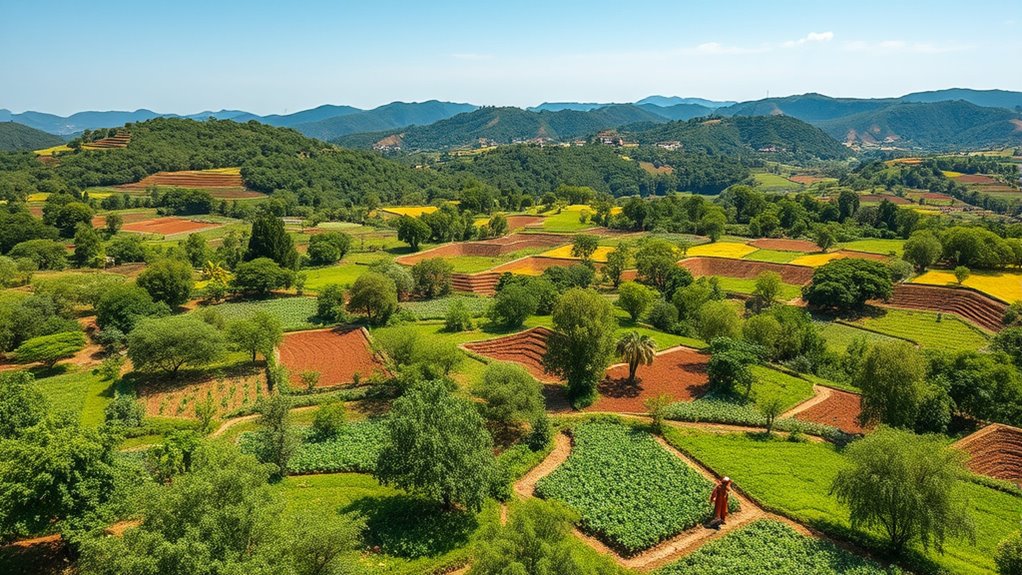
Addressing the economic and social considerations of agroforestry systems is essential for ensuring their widespread adoption and long-term sustainability. You need to understand that farmers and communities will only invest time and resources if they see clear benefits. Offering incentives, such as access to markets, fair pricing, or carbon credits, can motivate adoption. Social factors like land tenure security, cultural acceptance, and knowledge sharing also play crucial roles. You must involve local stakeholders early, respecting their needs and traditions, to build trust and commitment. Education and extension services can help demonstrate economic gains and practical benefits. By addressing these considerations, you create an environment where agroforestry practices are not only environmentally beneficial but also economically viable and socially acceptable.
Implementing Policy Frameworks to Support Agroforestry Adoption

Effective policy frameworks are fundamental to scaling up agroforestry practices and guaranteeing their long-term success. You need clear policies that incentivize farmers, streamline access to resources, and establish monitoring systems. To successfully implement these frameworks, focus on:
Strong policy frameworks are essential for sustainable agroforestry adoption and growth.
- Creating financial incentives like subsidies or carbon credits that motivate adoption.
- Developing technical guidelines and training programs to build farmer capacity.
- Establishing transparent regulation and enforcement to ensure compliance and sustainability.
Frequently Asked Questions
How Do Climate Change Impacts Affect Agroforestry Carbon Storage Potential?
Climate change impacts can reduce your agroforestry system’s ability to store carbon by causing more frequent droughts, storms, and temperature fluctuations. These stresses may weaken plant growth, increase tree mortality, and disrupt soil health, ultimately diminishing carbon sequestration. To maintain storage potential, you should select resilient tree species, implement adaptive management practices, and diversify your plantings to withstand climate variability and enhance long-term carbon storage capacity.
What Are the Best Practices for Engaging Local Communities in Agroforestry Projects?
You should actively involve local communities by holding participatory planning sessions, respecting their knowledge and needs. Offer training on agroforestry benefits and sustainable practices, and guarantee fair benefit-sharing. Foster transparent communication and build trust through consistent engagement. Empower community members to take leadership roles, encouraging ownership of projects. By aligning agroforestry goals with local priorities, you create lasting commitment and maximize project success.
How Can Technology Improve Monitoring Accuracy of Carbon Sequestration?
You can improve monitoring accuracy of carbon sequestration by utilizing remote sensing technologies like satellite imagery and drones, which provide real-time, precise data. Incorporate sensors that measure soil carbon levels directly, and use data analytics to track changes over time. Engaging with software platforms that analyze and visualize this data makes it easier to identify trends and verify sequestration efforts, ensuring more accurate and reliable results.
What Are Potential Trade-Offs Between Carbon Storage and Crop Yields?
You might find that increasing carbon storage in agroforestry systems can reduce crop yields by up to 20%, due to competition for resources like water and nutrients. To balance this, you need to optimize tree-crop arrangements, selecting species that complement each other. While carbon sequestration benefits climate goals, you must weigh these gains against potential decreases in productivity, ensuring sustainable practices that support both environmental and agricultural needs.
How Can Agroforestry Systems Be Adapted for Different Ecological Zones?
You can adapt agroforestry systems for various ecological zones by selecting native tree species suited to local climates and soils. Adjust planting densities and canopy structures to optimize light, water, and nutrient use. Incorporate local knowledge and traditional practices to guarantee resilience. Conduct site-specific assessments regularly, and modify management practices based on observed ecological responses, ensuring the system thrives while maximizing carbon storage and crop productivity.
Conclusion
By embracing agroforestry, you open a powerful tool against climate change—turning land into a carbon sink. As you select diverse tree species, design thoughtful layouts, and integrate sustainable practices, remember: every action plants a seed for a healthier planet. Don’t just imagine a greener future—make it happen. Because in the fight against climate change, your efforts today are the roots that will grow tomorrow’s hope.









